December 10, 2014
Political graffiti & art interventions’ transformative
function in the urban landscapes of Sofia
Written by Kiril Avramov
In 2014 Bulgaria has entered into its 25th year after the fall of state socialism and gradual exit from the orbit of the ex-Soviet bloc dominated by the USSR. This twenty-five year period has been dubbed as "dual post-socialist transformation /transition" (or "преход" in Bulgarian, literally "transition") towards liberal democracy and free market and consolidation and maturation of the complemenary institutions that match such political system. The early expectations in the nineties of the past century of political scientists[1], political economists and sociologists[2] and economists[3] alike were tuned to suggest that political liberalization after the fall of communism will be accompanied by a short – so-called "J-curved" economic adjustment (post-socialist economic recession) that will automatically put the ex-communist countries on the track of political and economic consolidation provided that liberal democracy and its institutions will foster environment for economic growth. Thus it was reasonable to expect that transitions would produce a "democractic tiumph" and an "economic boom" that would coexist in an infinate "honeymoon". However, instead of the expected results of these early models, the post-socialist states have exibited their heterogenity in terms of development trajectories, mainly due to the effects of the so-called "path-dependency"[4] stemming from the types of communism[5] practiced across Eastern Europe and its lasting legacies in terms of institutions, political party systems, civic society maturation and activity, and stage of pre-1989 economic development. Some of the Central and Eastern European states like Czech Republic, Poland and Hungary have opted for different paths of post-socialist development in terms of democratic consolidatuion and privatization of public property ("rupture with the past"), while others such as Bulgaria, Romania and Latvia have chosen to gradually "dismantle" the old system and slowly move forward. The speed and type of transition process selected has produced very different results in these respective states. In Poland the "shock therapy" coupled with existing traditions of active civil society and active alternative political, cultural and eventually economic "counter-elite” has produced one type of social results. In Bulgaria with its "patrimonial communism” legacy coupled with gradual transition and slower "laggard” type of democratic consolidation without real alternative "counter-elite” and relatively anemic civil society has produced what is known as "partial reform equilibrium” and eventually a socio-political condition termed as "state capture”[6] where the early "winners” of the "bloodless” transition (i.e. the implosion of the socialist state) were the ex-communist party nomenklatura and elites who were able to convert their former political capital into economic one, thus producing new type of "red burgeoisie” that raided the former state property converting it into new private business empires that fed back into the newly created oligarchic order in terms of financial and media support for the new political status-quo, dominated by the ex-communist, turned into the Socialist Party at the onset of transition.
The processes of "partial reforms equilibrium” and further "competitive state capture” did not leave the public discourse unaffected. Parallel to these processes, the Bulgarian public has withnessed an unprecedented consolidation of ownership of the so-called "traditional" channels of communication - mass media, print and later web sources of relevant political, economic and cultural information. Ever since the beginning of the new century Bulgaria has entered a downward trend[7] in terms of media freedom and pluralism.
Under these circumstances, due to its relatively low cost and wide availability, graffiti became an attempt to "break" the media monopoly of social interaction imposed by the commercial media. Besides attempted "street competition" to the media monopoly, political graffiti has a number of communication features that makes it a kind of political barometer and an expression of dissent and protest; advertising, political humor, social commentary and even an instrument of psychological warfare.
In the past few years the Bulgarian capital city saw massive social unrest becoming a scene of different types of continuous protests. All of them attempted to conquer and remodel the "sacred" urban power landscape and its monuments. During this period grafitti has served as a mechanism for revival and return of “forgotten” issues back into the mainstream public discourse, and as powerful a antidote to the mainstream public and private mass media “selective blindness” due its opaque ownership structure, concentration and constant deterioration of media pluralism and freedom.
At the very early stages of the post-socialist transition the simple and unsophisticated political graffiti dominated the urban landscape, as they require only basic artistic and other skills to produce. Thus manifestation of opposing ideologies and their symbols and slogans were commonplace in post-socialist capital of Bulgaria.
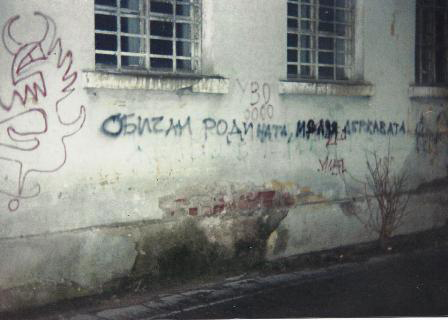
As the early post-socialist transition period advances towards consolidation (post 1992 and before the first “winter of discontent” in 1996) of the political system, party politics becomes more fragmented (post 2001) and moves away from the classic bi-polar model. Bulgaria faces so-called “strategic” choices in terms of geo-political orientation and foreign policy challenges (i.e. accession to NATO in 2002-2004 and to the EU in 2007), and at the same time political graffiti becomes more sophisticated in terms of content and making. From relatively simple slogans and symbols (i.e. manifestation of ideology), the authors opt for relatively more complicated pre-fabricated stencils.
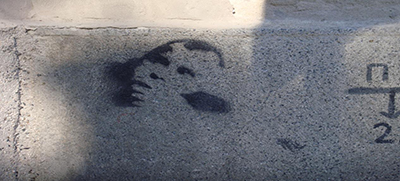
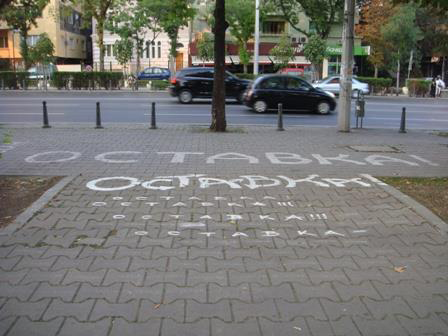
Media control is considered the most effective method of "immunization" of the general public concerning issues related to the legitimacy of decisions by the power elite, but also the "eclipse" of the dynamics of "alternative" political and social communities depriving them of access to the 'traditional' national media. For this reason precisely, what we call "ideologically alternative" communities or “counter-publics”[8] choose to instead use alternative distribution channels for their messages outside their communities. This choice determines the "alternative media" that they use – the “low- tech” graffiti and the “high-tech” social networks. In both cases, "alternative" means a strategy of asymmetric opposition - low-cost methods to spread their "alternative story" of social reality and their suggestions on how it can be changed. This asymmetry forces established political “mastodons'” increase input in traditional channels of mass communication on the one hand and on the other forces them to enter into the territory of alternative channels - from graffiti to social networks. Meanwhile, the elites both of traditional and "alternative" players on the political scene use the opportunity to enhance the cohesion and engagement of the membership and sympathizers via encouraging “middle level” activists or the so-called "party sub-elite" to be personally involved and participate actively in the creation and writing of real and virtual graffiti, along with non-affiliated but discontent civic protesters, anarchists, neo-Nazis, anti-globalists and representatives of the radical far left.
Political graffiti & art interventions – the case of the Soviet Army Monument in Sofia
Like most of the former Eastern and Central European member countries of the ex-Soviet Block Bulgaria since the fall of the Berlin Wall has experienced gradual removal or replacement of Soviet era commemorative monuments. The most notable events in the capital city in that respect were the removal of Lenin’s statue that used to overlook the so-called "triangle of power" (i.e. the space between the buildings of the Council of Ministers (seat of the central government), the Presidential building and the massive ex-Party House, now-turned into National Assembly’s members’ building at the absolute center of the city) and the demolition of the mausoleum of Georgi Dimitrov. However, despite the high level of polarization of public opinion regarding the monuments, especially the ones dedicated to the “liberator” Red Army and their historic and aesthetic value, Bulgaria did not reach escalation levels comparable to that of, say, Estonia during its “monuments war”[9]. Despite the gradual “disappearance” of these types of monuments, the one that stirs the largest controversy in Bulgarian public life since 1989 is the towering composition titled “Monument of the Soviet Army” located at the heart of Sofia and dominating its central part skyline. The initial works on the memorial complex that consists of main piece – a 37 meter high column with a central statue of a Soviet soldier, surrounded by a male and a female figures behind, personifying the working proletariat and peasantry respectively, and other smaller surrounding components, began in 1952. In 1954 it was officially opened with a state ceremony featuring soviet military top brass. It is important to note that the monument has been planned by an entirely Bulgarian team of architects and sculptors and its initial idea was to honor the role of the Red Army in the process of the liberation of Bulgaria. Despite the fact that the monument became a center of public controversy immediately after the implosion of state socialism in 1989, it was not until 1993, that the (anti-communist, UDF dominated) Municipal Council decided to dismantle the monumental complex in the center of the city. It did not receive wide civic support and had to delay and later entirely abandon the execution of its own decision. Interestingly, during the “first winter of discontent” in 1996/97 when there was a mass civic unrest against the Socialist government, the protesters and rioting students and subsequently the UDF government under Ivan Kostov (1997-2001) did not take any actual steps to dismantle it either. It was not until 2010-2012 that newly formed civic initiatives and pressure groups “reopened” the issue of monument removal[10] with annual happenings dedicated to collective memory preservation and “re-building”. In January 2011 the monument debate came to a new boiling point when Sofia’s Municipal Council (dominated by the right-centrist GERB) was pressured to execute the decision from 1993 but failed to garnish support again (just as in the case with the UDF) and created a situation where two opposing pressure groups pro and against (led by the most vocal “Che Guevara” movement”) the dismantling of the monument were protesting simultaneously and were kept apart by the city police.[11]
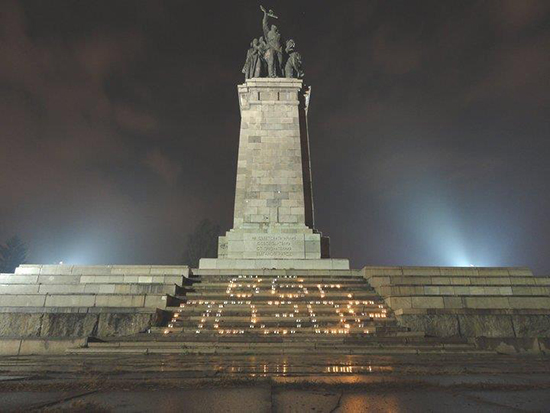
Probably due to the political elites' long time inaction and “selective blindness” (i.e. lack of former decision) about the fate of the monument and constant hide-and-seek game between the Sofia municipality and the executive power since 1993, as well as the complexity stemming from the geopolitical re-orientation of Bulgaria (NATO, etc.), this “sacred” space of political contest in the urban environment became the virtual center of all protest activity against what non-elite participants in civic unrest saw as the local oligarchy’s “clinging to the past” practices, formed and influenced by the former USSR and later Russian Federation. Thus political elites from different configurations of power from Socialists to right wing Christian Democrats have provided a public “niche” with exact physical location to become a focal point for alternative media (in terms of political graffiti and art intervention) to concentrate its messages and to boldly provoke those in power in Bulgaria and abroad, especially in times when there is a silent, general discontent with the political class at large. Due to this peculiar status and function of the Monument, a single political graffiti action towards it automatically rearranges its meaning and initial idea to turn it into a highly visible “display board” for dissent that creates not only local political confrontation but transforms it from purely internal to foreign policy scandals, provoking sharp diplomatic reactions that immediately capture the attention of mainstream television broadcast, print and social media in Bulgaria and abroad. Thus on June 17th 2011 the monument became the stage of a spectacular art intervention titled "Abreast with the time”/“В крак с времето”(in Bulgarian) where the Soviet soldier sculptures located at the sides of the main architectural piece receive a spectacular makeover to become the well-known comic heroes – Superman, the Joker, Wolverine, the X-Man, Santa Claus and Captain America[12], an anonymous work that was later claimed to have been staged by a group of artists united under the umbrella of “Destructive Creation”[13] art collective that was able to polarize Bulgarians and draw the attention of the foreign media almost instantly.
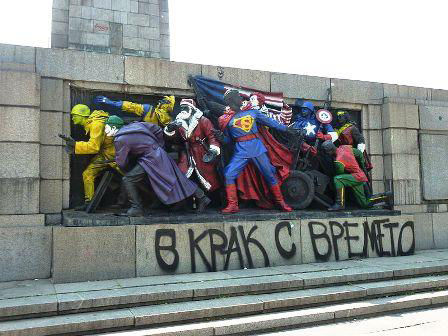
In the winter of 2012, the same soldier sculptures received Guy Fawkes masks as a symbolic anti-ACTA protest action in Bulgaria and in August the same year a few of the figures receive colored hoods over their heads, the same as the ones used by the members of the Russian punk rock band “Pussy Riot” in order to support the members that became subject of prosecution by Kremlin. Next year on the Day of Remembrance of the victims of communism (1st of February) three of the heads of the sculptures are painted in white, green and red – the colors of the Bulgarian flag, while on the 21st of August 2013 “The Red Army goes Pink”[14] in an art installation titled “Prague ‘68” to commemorate the anniversary of the crush of Prague Spring in 1968 by the collective forces of the Warsaw Pact led by the Red Army. Easily spotted was the text of the graffiti – “Bulgaria is apologizing!!!” in Czech and Bulgarian languages as an apology on behalf of the Bulgarian armed forces’ participation in Prague’s 1968 occupation, and "Excuse yourselves” (only in Bulgarian) towards the supposed Russian recipients. The international reaction was almost instant, as the major news agencies[15] spread the news of the Bulgarian apology around the globe and showed how the Red Army had gone pink. On the very next day, the 22nd of August, the Russian authorities (Foreign Ministry of the Russian Federation) reacted very sharply via official diplomatic channels demanding from the Bulgarian executive and local power to formally punish the authors for "profanation of monuments of Soviet soldiers” in Bulgaria, as they deemed that the cases were multiplying and that no official reaction towards the mandatory cleaning of the monument after such actions was carried out. As a result of the art intervention the Bulgarian Minister of Foreign Affairs, Kristian Vigenin, called for calm and asked the Russian side to not overreact. At the same time Sofia’s Regional Prosecutor’s Offices launched pre-trial proceedings against the unknown author for vandalism[16].
However these developments did not prevent or discourage civic activists and creative authors to continue to use the monument complex for further bold politically motivated art interventions, as in the summer of 2013 when the monument sees another action – this time dubbed "Monument of Gazprom”.
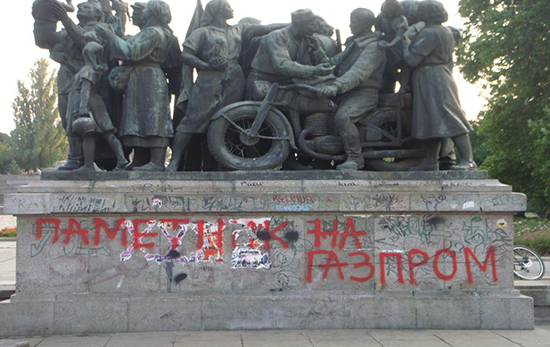
In 2014 the monument sees three more spectacular interventions in February, March and April, as the first one is dedicated to the support and solidarity with the Ukrainian protesters at the Maidan, titled "Слава Українi“ / “Glory to Ukraine” (in Ukrainian).
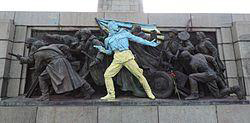
Whereas the March graffiti action was dedicated to the protest against the Russian invasion of Crimean peninsula – large graffito at the bottom of the central piece read “Hands off Ukraine”, the April interaction was a commemorative piece titled "KATYN 5.III'40" containing a makeover of one of the soldier sculptures in white and red colors (as are the colors of the Polish flag) waving the Bulgarian tricolor and a second figure in blue and yellow (as in the Ukrainian one) side by side. The central piece sported graffito „PUTIN GO HOME”!
Dr. Kiril Avramov is Assistant Professor of Political Science at the New Bulgarian University in Sofia
Notes
1 Fukuyama, F. (2006). The end of history and the last man. Simon and Schuster.
2 Stark, D., & Bruszt, L. (1998). Postsocialist pathways: Transforming politics and property in East Central Europe. Cambridge University Press.
3 Fidrmuc, J. (2003). Economic reform, democracy and growth during post-communist transition. European Journal of Political Economy, 19(3), 583-604.
4 Kitschelt, H. (Ed.). (1999). Post-communist party systems: competition, representation, and inter-party cooperation. Cambridge University Press.
5 Linz, J. J. (1996). Problems of democratic transition and consolidation: Southern Europe, South America, and post-communist Europe. JHU Press.
6 Hellman, J. S., Jones, G., & Kaufmann, D. (2000). Seize the state, seize the day. Policy research working paper, 2444.
7 Annual Report of the Bulgarian Helsinki Committee 2011, Freedom of Expression, http://www.bghelsinki.org/bg/temi/svoboda-na-izrazyavane/ , last access August 2014.
8 Warner, M. (2002). Publics and counterpublics. Public culture, 14(1), 49-90.
9 Eckholm, Sara, “Monument Wars”, Letter from Tallinn, Foreign Affairs, January 7th 2014, http://www.foreignaffairs.com/features/letters-from/monument-wars , last access in August 2014.
10 http://www.dnevnik.bg/bulgaria/2012/11/09/1943980_grajdani_otnovo_poiskaha_subarianeto_na_pametnika_na/ , (In Bulgarian), last access August 2014.
11 http://www.trud.bg/Article.asp?ArticleId=735715 , (In Bulgarian), last access August 2014.
12 http://www.huffingtonpost.com/2011/06/20/bulgaria-soviet-army-monument-superhero-makeover-superman-captain-america-_n_880583.html , last access August 2014.
13 http://destructivecreation.com/?p=152#comments
14 http://www.theguardian.com/world/2013/aug/21/soviet-army-monument-pink-painted-bulgaria
15 http://www.reuters.com/article/2013/08/21/us-bulgaria-monument-czech-idUSBRE97K0G520130821
16 http://www.novinite.com/articles/153091/Bulgaria's+FM%3A+Don't+Dramatize+Memorial+Desecrations









